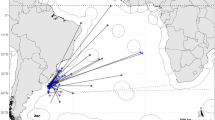Abstract
The distribution and behaviour of cormorants in estuarine environments was examined on the central coast of New South Wales, Australia, with respect to habitat associations at different spatial scales. No consistent variation in abundance was found for four species of cormorants (great Phalacrocorax carbo, pied P. varius, little black P. sulcirostris, and little pied P. melanoleucos) with state of tide (high and low) and time of day (early, middle, and late) at five estuarine locations. Differences in abundance were found among locations that were not confounded by short-term temporal variation (i.e. time of day and tide). Differences in abundance were detected among habitats (e.g. bays, creeks, and headlands) separated by hundreds of metres to kilometres in different estuaries. Cormorants of all species were rare on the open coast and near the entrance of estuaries. Abundances of cormorants varied greatly within and among creeks, bays, and river channels. Presence of seagrass beds explained much of this variation and most of the cormorants swimming and feeding were found near seagrass. Mapping of seagrass beds and the positions of cormorants at scales of metres to hundreds of metres showed a close relationship between the presence of swimming and roosting beds and the presence of seagrass beds for P. melanoleucos and for P. carbo. We argue that cormorants make decisions to visit particular estuarine habitats, especially those with seagrass, where many types of prey (e.g. fish and crustaceans) are probably most abundant. These choices must be interpreted in the context of decisions that cormorants make on scales of hundreds to thousands of kilometres during periodic excursions to the interior of Australia. Further, environmental threats to seagrass beds could impinge on these mobile visitors to the same extent as on more permanent residents.
Similar content being viewed by others

Author information
Authors and Affiliations
Additional information
Received: 14 February 2000 / Accepted: 17 July 2000
Rights and permissions
About this article
Cite this article
Dorfman, E., Kingsford, M. Environmental determinants of distribution and foraging behaviour of cormorants (Phalacrocorax spp.) in temperate estuarine habitats. Marine Biology 138, 1–10 (2001). https://doi.org/10.1007/s002270000437
Issue Date:
DOI: https://doi.org/10.1007/s002270000437



